HONG KONG – A string of new museums that has sprouted along Kowloon’s waterfront is transforming Hong Kong into an art lover’s paradise.
And it is not just great art. Artworks are in duet with splendid views of Victoria Harbour and Hong Kong island’s suave skyline.
I watch the gold facade of the Hong Kong Palace Museum shimmer and discern echoes of tradition recast. The new museum is home to more than 900 treasures loaned from Beijing, alongside contemporary shake-ups of Chinese antiquities.
Leaving the decadent past of the Forbidden City behind, I stroll across to M+ and lose myself in Japanese artist Yayoi Kusama’s infinity room. The museum of visual culture whispers unheard stories behind Asia’s teeming design and art scenes.
The M+ building, designed by architects Herzog & de Meuron of Tate Modern fame, is its own visual story, with a sleek ebony billboard towering above its 33 galleries.
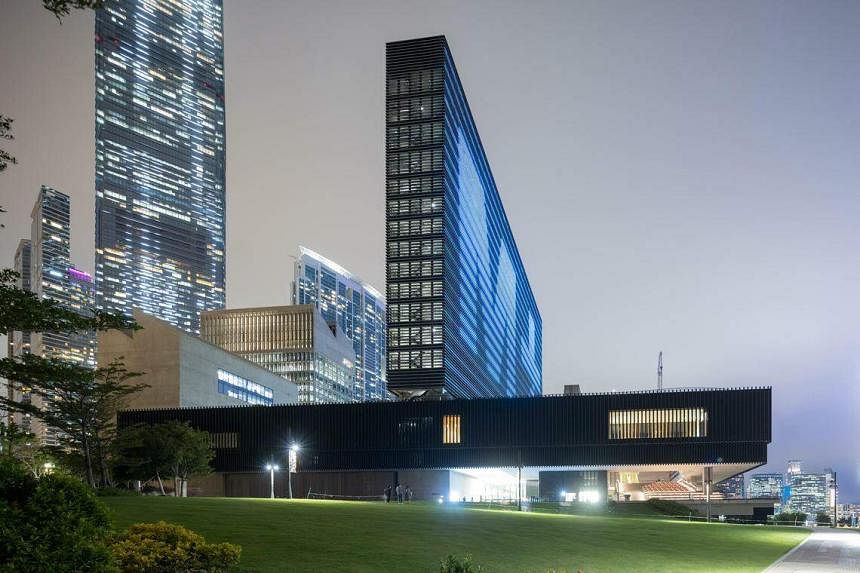
An art park stretches between the two museums, and families grab snacks from food trucks to picnic on the grass. On Friday and Saturday nights, one can enjoy free outdoor live music by Hong Kong acts and sip on local craft beer from Mak’s Brewery.
Launched mostly during the pandemic in West Kowloon, these are part of a swanky cultural core that also includes an auction house and a Chinese opera theatre.
I could easily spend a weekend wandering the 40ha cultural promenade, but the museum-hopper in me knows that a 20-minute ride on bus 973 to the east promises more art.
And so I arrive at Tsim Sha Tsui and step into the newly reopened Hong Kong Museum of Art – the city’s oldest public art museum – which has been given a facelift. A fresh glass encasing has usurped its old brick exterior after a four-year renovation.
It is still the best place in the city to see art from a Hong Kong viewpoint, with a full slate of local curators and a focus on commissioning local artists.
At the Avenue of Stars, which pays tribute to legends in the entertainment industry, Cantopop stars like Anita Mui enchant me – but newcomer K11 Musea is a scene-stealer.
The sprawling art and retail hybrid, while not strictly a museum, allows me to muse and be amused.
Art dangles off ceilings and bursts from the ground while I try on casual wear at Public Tokyo and marvel at furniture from the Museum of Modern Art design store.

Both the Hong Kong Museum of Art and K11 Musea opened their doors to visitors in 2019, when Hong Kong’s largest pro-democracy protests deterred tourists.
The city’s older museums, scattered throughout the city, were never popular with tourists, who prefer tax-free shopping, local cha chaan teng eateries or Disneyland.
For decades, the financial hub wore the moniker of “cultural desert”. But Kowloon might well be the site of a new cultural bloom.
When night falls, the four museums – largely new to an international audience – stand illuminated like eager emblems of Hong Kong’s reinvention.
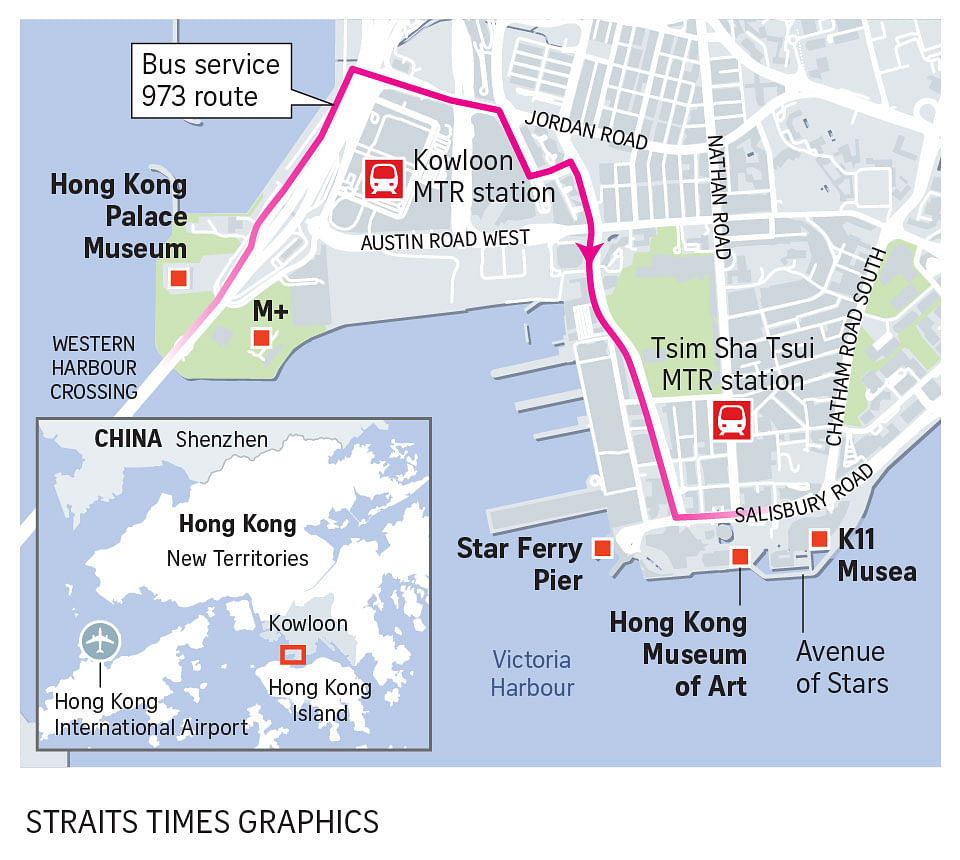
Culture vultures who swoop into the city will enjoy the rotating slate of international exhibitions and local programmes throughout the year. Casual art lovers can enjoy a day out and score incredible pictures.
No one, however, will be able to see everything. I have tried. So here are 10 artworks you must see in Kowloon’s arts waterfront.
M+
Who should visit: Lovers of cutting-edge art, design and media from Asia
Where: 38 Museum Drive
Admission: HK$120 (S$20, standard) and HK$60 (concession), go to str.sg/i4B5
1. Yayoi Kusama’s Portrait (2015)

From her polka-dot pumpkins to galactic infinity rooms, Kusama is instantly recognisable. An exhibition of the superstar artist’s work at the National Gallery Singapore in 2017 was seen by more than 235,000 visitors.
But beyond the hype, how much is known of the elusive avant-gardist?
This self-portrait strikes me as an invitation to know the woman behind her fame. Here, Kusama exudes a warm presence while radiating the aura of an otherworldly artist.
Kusama, who checked herself into a psychiatric institute in Tokyo in 1977, continues to work in her studio from across the hospital at the age of 94. The creations on show offer an intimate entry into her life’s work without losing sight of the artist.
See it at Yayoi Kusama: 1945 To Now, which is on till May 14, for HK$240 (standard) and HK$150 (concession).
2. Kacey Wong’s Paddling Home (2009)

In 2009, Hong Kong artist Kacey Wong built a house out of trash for the sea. His miniature apartment was an assemblage of found objects buoyed by plastic barrels and rubber tyres, floating in Victoria Harbour.
Dressed in a pristine sailor’s uniform and an orange life jacket, Wong climbed on and paddled away on the high seas in 2010.
The provocateur made a point about the risky business of living in one of Hong Kong’s cramped and expensive apartments.
In 2021, the performance artist fled to Taiwan. This sculpture is a piece of the artist that has managed to remain in Hong Kong, even as the work – meant for the waters – is now land-bound.
See it at Hong Kong: Here And Beyond till June 11, admission is free.
3. Wen Pulin’s Seven Sins (1989 to 2009)
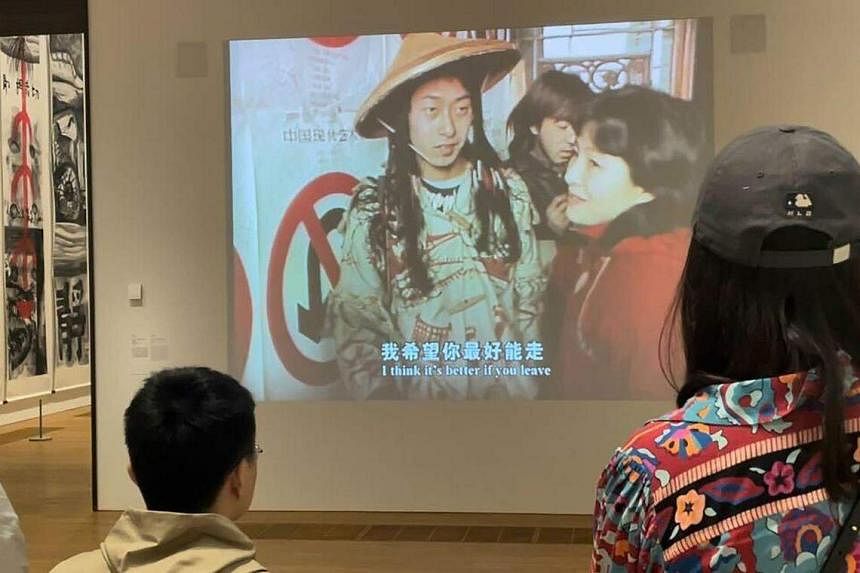
At China’s first exhibition of avant-garde work, performance artist Xiao Lu fired at her installation with a pistol, which led to the authorities shutting down the show.
This is one of the seven “sins” of performance art that documentary film-maker Wen Pulin captured on camera at the ground-breaking No U-Turn exhibition in 1989.
Video works in museums do not usually draw crowds, but on my visit, I see a group of attentive young Chinese tourists watch quietly as the 52-minute documentary plays.
For those unfamiliar with contemporary Chinese art history, the exhibition is a revelation. It moves through the early attempts of artists to break free from socialist realism to the global fame of artists like Ai Weiwei today.
See it at M+ Sigg Collection: From Revolution To Globalisation till July 23.
4. Section model of National Stadium (2002 to 2008)

Design nerds will relish an opportunity to see models of iconic Asian architecture up close, including a section model of Beijing’s National Stadium, better known as the “bird’s nest”.
Designed by Ai and Herzog & de Meuron – the same Pritzker Prize-winning architects who designed the M+ building – the work is displayed in a section that tackles the rise of postmodern architecture in Asia.
See it at the ongoing show Things, Spaces, Interactions.
Hong Kong Palace Museum
Who should visit: Seekers of traditional Chinese culture with a twist
Where: 8 Museum Drive
Admission: HK$50 (standard) and HK$25 (concession), go to str.sg/i4Bc
5. Pair of cabinets with scenes from the Romance Of The Three Kingdoms (17th century)

One of the world’s largest collections of classical Chinese furniture in Hong Kong belongs to antique aficionado Peter Fung.
Much of his collection is on display at the four-storey Liang Yi Museum in Hollywood Road, Sheung Wan. But this pair of cabinets is shown here in an intriguing study-room arrangement.
It forms part of an exhibition that illuminates the culture of collecting in Hong Kong, and is a unique aspect of the museum that is not found in Beijing’s Palace Museum.
See them at Private To Public: The History Of Chinese Art Collecting In Hong Kong.
6. Gaybird’s A Grandiose Fanfare (2022)

If you thought the Palace Museum was going to be stuffy, you will catch a breath of fresh air with Hong Kong artists’ reinterpretations of palace treasures.
Six works are on display, but sound artist Leung Kei-cheuk or Gaybird’s 31-channel sound installation shouts for attention. After all, people know more about what the Forbidden City looked like than what it sounded like.
The sound of popping balloons at times reminds me of fireworks, and at others, is reminiscent of gunfire. I am not sure what to make of these sounds, but relish the opportunity to eavesdrop on history.
See it at the ongoing show, No Boundaries: Reinterpreting Palace Museum Culture.
Hong Kong Museum of Art (HKMoA)
Who should visit: Families with young ones who want to immerse in and interact with art
Where: 10 Salisbury Road
Admission: Free, go to str.sg/i4BN
7. Angel Hui Hoi-kiu’s Make A Wish (2022)

This feast for the emperor is a buffet for the eyes. Inspired by the blue porcelain ceramics on show at the museum, Hong Kong artist Angel Hui aimed for splendour.
Make A Wish marks the 500th anniversary of the Jiajing Emperor’s ascent to the throne and displays 500 items stretching across a 14m dining table. I gawk at the opulence of suckling pigs and dimsum, and also get an eyeful of gramophones and face masks.
This site-specific work is set against the Hong Kong skyline. The work’s blues mirror the ceruleans of the harbour and make for a stunning photograph.
See it at 3/F Lobby till June 14.
8. Joan Miro’s Woman And Bird (1967)
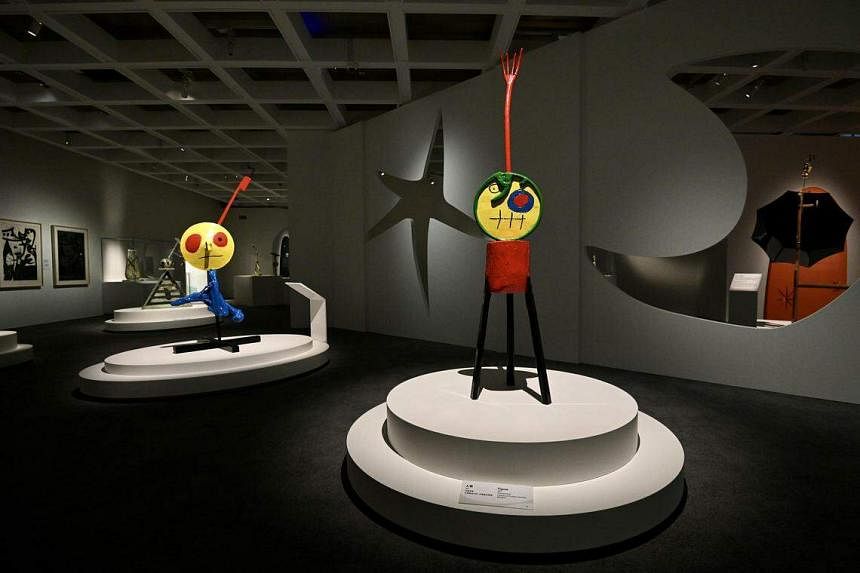
Kids will enjoy the whimsical human figures dreamt up by 20th-century Spanish master Joan Miro.
Woman And Bird, a bronze figure slicked in primary colours, stares back at you and tickles the imagination.
The exhibition is accompanied by a fantasy playground, Miroland, where young ones can get crafty and take home a souvenir.
See it at Joan Miro: The Poetry Of Everyday Life till June 28, for HK$30 (standard) and HK$15 (concession).
K11 Musea
Who should visit: Shopaholics or those who believe art should be an experience
Where: 18 Salisbury Road
Admission: Free, go to str.sg/i4Bf
9. Michael Lau’s The Flowery Surprise (2022)
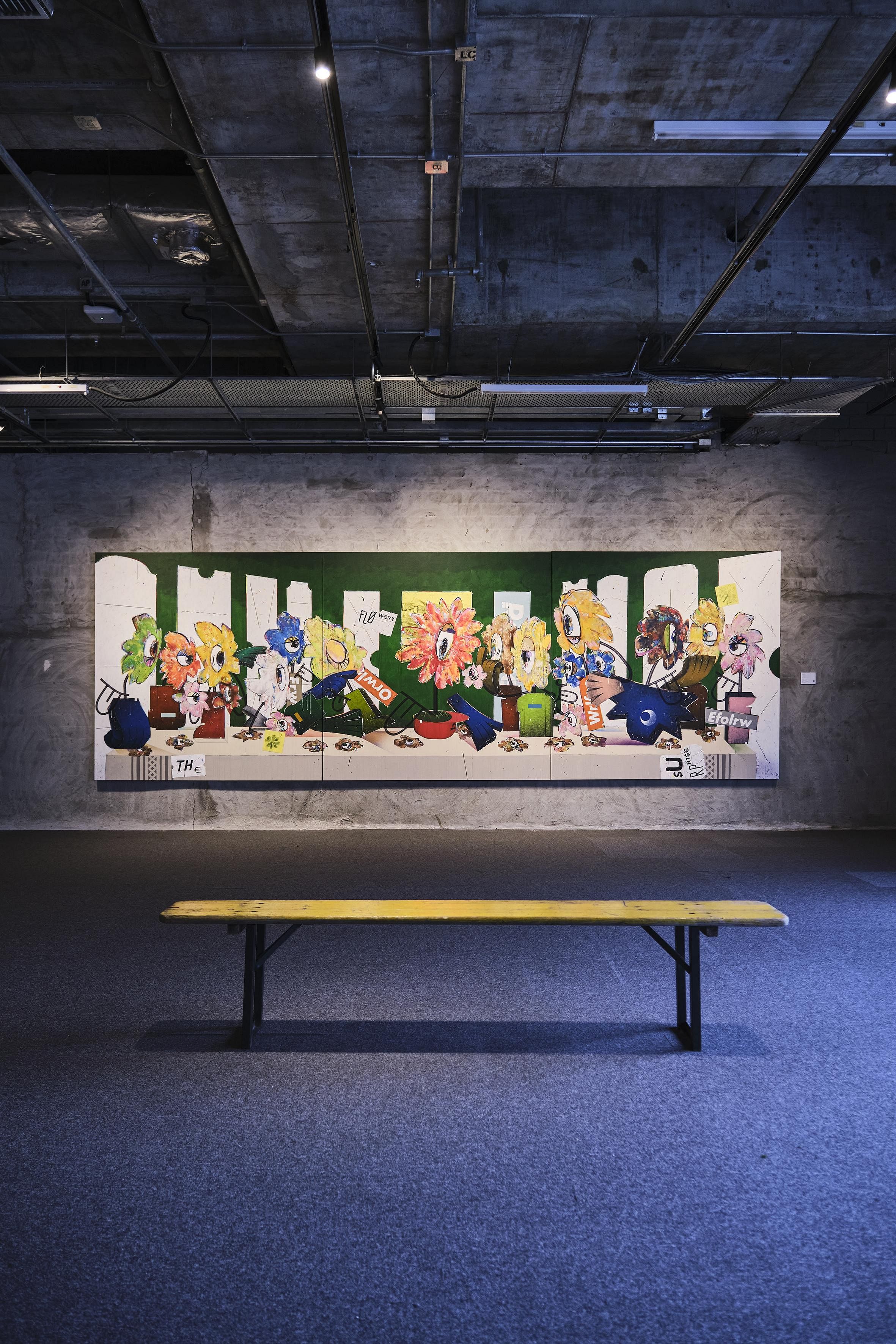
Hong Kong artist Michael Lau’s triptych captures the spirit of K11 Musea best. A reference to Leonardo da Vinci’s Last Supper, The Flowery Surprise is Lau’s reinterpretation of a Western masterpiece, and his cheeky spin on high art.
It is not just the one-eyed flowers, but the canvas is also interspersed with fashion labels and price tags, blurring the boundary between art and consumption. Sit on a bench and take in the art, then get right back to shopping.
See it at K11 Musea, Level 6.
10. Aiko’s Kiss (2017)

Street art and graffiti are genres that are dominated by men like British artist Banksy and American artist Keith Haring. So it is refreshing to spot works by women artists like Aiko Nakagawa in City As Studio.
In Kiss, the Brooklyn-based artist gives artistic visibility to femininity on the streets through a visual language that includes spray-painted flowers and stencilled girl-power slogans.
See it at City As Studio till May 14, for HK$100 (standard) and HK$50 (concession).
Dining
On the go: Food trucks at Art Park (West Kowloon Cultural District, Kowloon). Try a modern twist on the pineapple bun (about HK$28) or a classic burger (about HK$120) with vegan options. Chill on the benches or take along a mat to picnic here.
Casual dining: Peony Garden (G/F, Xiqu Centre, Unit No. 2-3, 88 Austin Road W, Tsim Sha Tsui). Take a detour and try Hong Kong comfort food. Locals rave about the coriander rice noodle soup (about HK$88).
Fine dining: Mosu Hong Kong (3/F, M+ Tower, West Kowloon, 38 Museum Drive). A Korean fusion fine-dining offshoot of the three-Michelin-starred Mosu Seoul. Reservations must be made months in advance and only dinner (HK$2,398 a person) is available.
Tips
Avoid museum fatigue
Studies have shown that museum fatigue sets in as early as 30 minutes into an exhibition. When lethargy hits, I opt for an audio guide or look out for a free public tour. Spend five minutes with an artwork, rather than a minute on five works. Find a comfy seat to journal about what you see. Above all, plan in advance which galleries are “must see” and which are “good to see”.
Take in the harbour views
Four new art museums mean four new ways to take in the Hong Kong skyline. The viewing deck on the fourth floor of the Palace Museum offers a stunning view of Lantau island, while K11 houses an outdoor sculpture park that overlooks the Avenue of Stars. Every floor in HKMoA boasts a floor-to-ceiling window that frames the view. In the evening, I pick a window seat for dinner at M+’s ground-floor restaurant, ADD+, and bask in the gorgeous sunset.
Seek kid-friendly activities
M+’s Learning Hub, where themed family day events are organised, should be the first place to head for on the ground floor. Immerse the young ones in the multimedia installations at the HKMoA before they see the other artworks on display. In the basement of K11, the Legoland Discovery Centre can serve as a two-hour break from a day of museums and shopping. The Palace Museum is a tougher sell for kids, so keep the itinerary snappy.
- The writer was hosted by the government of the Hong Kong special administrative region.

